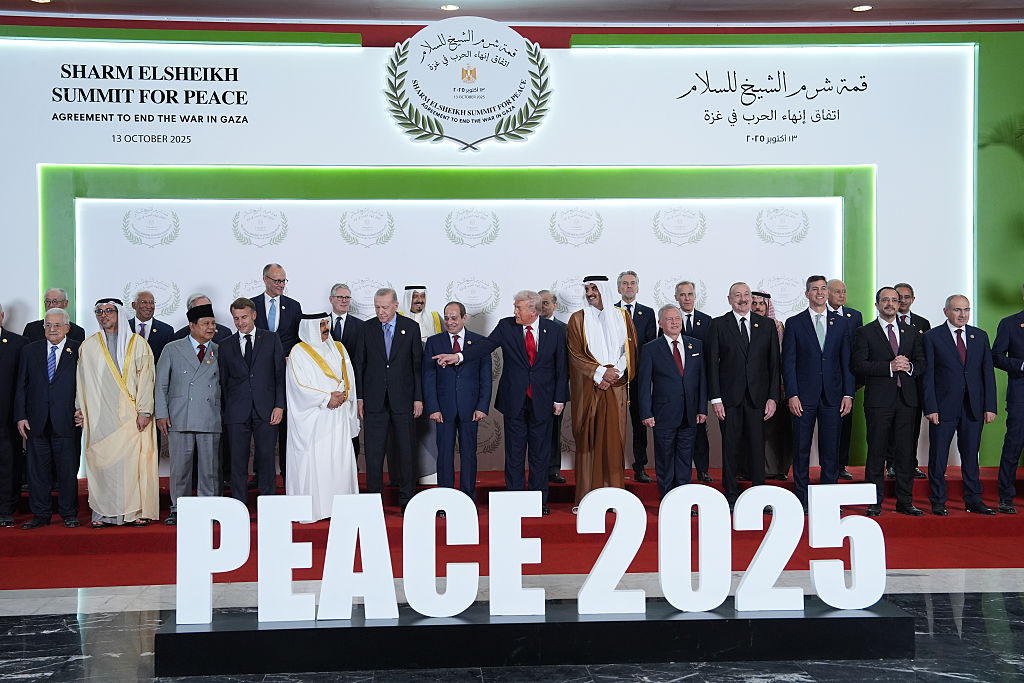The Sharm El Sheikh Peace Summit of October 13, 2025, concluded with over twenty world leaders signing the “Trump Declaration for Enduring Peace and Prosperity,” celebrating a ceasefire agreement between Israel and Hamas after more than two years of devastating conflict in Gaza. Yet the most striking feature was not who attended, but who did not. Neither Israeli nor Hamas representatives were present—the central parties to the conflict were absent from their own peace celebration.
This absence recalls an older story about recognition, rejection, and the price of saying “no” when history offers its rarest gift: the word “yes.”
The Forgotten Debate of May 1948
Few remember that declaring the State of Israel was hardly a foregone conclusion for David Ben-Gurion. He won only a narrow 6-4 vote for independence after nearly twelve hours of contentious debate on May 12, 1948. Some members of the national committee opposed the UN partition plan because it required accepting concessions to Jewish claims on the whole British Mandate of Palestine-Eretz Yisrael in exchange for statehood. Only the votes of two members of the Left-Zionist MAPAM party, who promoted coexistence with Arabs, secured victory for Ben-Gurion. Upon learning of this prolonged debate, Chaim Weizmann, soon to become Israel’s first president, reportedly quipped: “What are they waiting for, the idiots.”
The deliberations at Independence Hall reveal something contemporary discourse often overlooks: Israel’s founders anticipated and welcomed the creation of a Palestinian Arab state. This expectation shaped even the most basic question of what to call the new Jewish state.
What’s in a Name?
The provisional government’s debates about naming their state expose the reciprocal nature of recognition they envisioned. “Palestina” was rejected since it was imposed by the Romans after suppressing the Bar Kokhba Revolt in 135 CE—an attempt to erase Jewish connection to the land. Yet “Judaea” was also dismissed because most of that historical province had been allocated to the prospective Arab state under the U. N. partition plan.
One pragmatic proposal suggested dividing the two states geographically: “Western Palestine” for the Jewish state and “Eastern Palestine” for the Arab state. In Hebrew, this would have been Western Eretz Yisrael and Eastern Eretz Yisrael—preserving both the Palestinian name and the Jewish national identity.
But the debate ultimately shifted against using “Palestine” in any form for the Jewish state. The reason, preserved in the formal minutes, is revealing: “It is likely that the Arab state that will be established in the Land of Israel will be called Palestine in the future, which could cause confusion.”
Palestine was recognized by the Jewish state-in-the-making even before Israel itself was declared. The founders reserved the name “Palestine” for what they assumed would be their Arab neighbor. This was not mere magnanimity—it was practical recognition that two national movements, two peoples, would share one homeland under the UN’s partition framework.
That mutual recognition never came. The failure of reciprocal generosity by the Arab national movement led directly to the 1948 war and the lost opportunity for Palestinian statehood envisioned by the UN resolution of November 29, 1947, along with subsequent attempts to reboot it under Clinton, Bush, and Olmert-Abu Mazen proposals.
The Pattern Repeats
At Sharm El Sheikh, critics noted that despite lofty rhetoric, the signed declaration “was criticized for being simplistic and offering few details concerning how to achieve a regional peace agreement.” Israeli Prime Minister Benjamin Netanyahu initially accepted an invitation but withdrew, reportedly fearing blowback from his right-wing political base. Hamas sent no representative at all and appears to be walking very slowly in implementing their agreement while shooting Palestinians opposing them in Gaza.
The pattern from 1948 persists: international recognition without reciprocal commitment from the parties themselves. Just as the maximalist Husseini clan violently suppressed moderate Palestinian factions like the Nashashibi family who supported the 1947 partition, today’s internal Palestinian and Israeli politics remain trapped by those who reject compromise from extremist positions.
The question is not whether nations should recognize Palestine—many already have. The question is whether Palestinians and Israelis will recognize each other—not as abstractions to be managed by international conferences, but as legitimate national movements entitled to sovereignty, self-determination, security, and dignity. Recognition by third parties is easy. Self-recognition—the acknowledgment that one’s own claims must be limited by the legitimate claims of others—remains the harder path. That was the choice facing the Zionist movement in 1948. It is the choice still facing parties in ending the conflict today.
History does not grant unlimited opportunities to say “yes.”
From Theater to Practice
In 1948, Israel’s founders chose to say “yes” to partition despite the sacrifices it required, reserving the name “Palestine” for their anticipated Arab neighbor. That neighbor never emerged because Palestinian and Arab leadership chose “no.”
The number of aspiring nations in history far exceeds those that achieve statehood. Israel’s achievement of statehood and improbable economic success is the exception in history, not the rule. The success of independence movements often hinges on global power involvement, but internal factors such as political integrity and economic viability matter most.
The success of independence movements often hinges on global power involvement, but internal factors such as political integrity and economic viability matter most.
In 2025, after more than two years of war that left Gaza devastated and thousands dead on both sides, world leaders gathered in Sharm El Sheikh to sign declarations and pose for photographs while the actual parties to the conflict stayed home.
Extremist elements in both national camps—Jihadists and Kahanists—are waiting for the other side to cease to exist, a condition that will never be met. Until both peoples accept recognizing their neighbor’s rights and mutual interests, international conferences will produce only photo-ops and empty declarations.
The “day after” must move from the theatrical to the practical. This requires unleashing the unrealized potential of the Abraham Accords—themselves targeted by Hamas, Iran, Hizbollah,Yemen’s “ring of fire” on October 7, 2023—and redirecting hopes toward inter-regional economic growth through solving transboundary challenges.
The Abraham Accords represented a strategic reversal of the Oslo premise. Rather than waiting for bilateral Palestinian-Israeli peace to precipitate regional peace from inside the conflict outward, the Accords demonstrated that regional integration could unlock an Israeli-Palestinian agreement. A RAND Institute study found that recent normalization agreements could create more than 5 million new jobs and $1 trillion in new economic activity over the next decade.
The Abraham Accords demonstrated that regional integration could unlock an Israeli-Palestinian agreement.
Models exist. A creative “water-electricity” swap plan was approved: Jordan supplies solar energy to Israel while Israel provides desalinated water to the Palestinian and Jordanian communities. This project design can inform other transboundary initiatives supporting regional sustainable development. Palestinians, Israelis, Jordanians, Egyptians, and businesses and investors from throughout the region are working on many other projects that need the political air cover to advance and that is the hope that emerged from Sharm last week.
The region faces staggering challenges demanding cooperative solutions. More than 50% of MENA residents live in energy poverty. The region has the highest water stress in the world, with 60% of the population lacking access to drinkable water. With youth unemployment exceeding 25%, the region faces a demographic time bomb rather than a demographic dividend. Regional sovereign wealth funds hold more than $4.1 trillion that could be channeled into sustainable infrastructure projects with private investors.
Time is running out to demonstrate tangible results. Without changing facts on the ground for young people—and fast—the region will default to continued conflict over increasing scarcity. Congress should revive the Abraham Fund, frozen since 2021, originally designed to mobilize $3 billion from the US and $10 billion from the UAE and other Abraham Accord countries to advance desperately needed environmental, trade, energy, water, and agricultural projects.
The real test of peace is not whether the world recognizes Palestine. It is whether Palestine and Israel finally recognize each other—that essential connection of living mutual action and reciprocity needed to build the future of all humanity. Hope is a good breakfast, but a bad dinner. We must move from photo opportunities to an unstoppable tide of sustainable projects that prove cooperation and prosperity go hand in hand.
Glenn Yago is Senior Director of the Milken Innovation Center-Van Leer Jerusalem Institute, teaching at Hebrew University Business School and UC-Berkeley, and Senior Fellow-Founder, Financial Innovation Labs at the Milken Institute. www.milkeninnovationcenter.org




